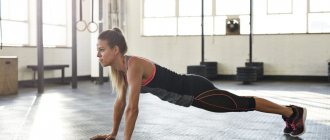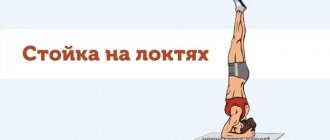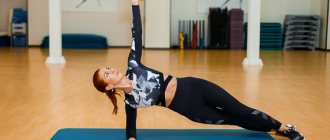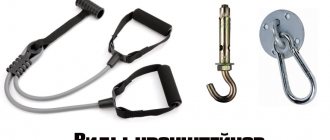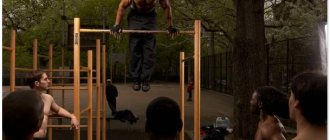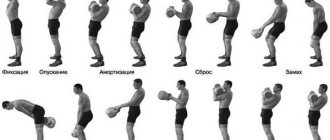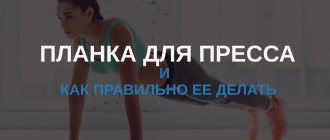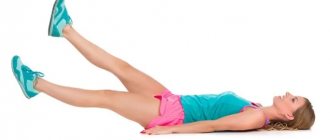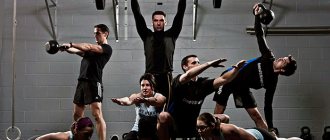Everyone knows the plank - as a static exercise that is held for a certain time, strengthening the abdominal muscles and core muscles in general. The plank has existed since ancient times, it came from yoga, but dynamic options appeared and changed with modern trends, such as: functional training, crossfit, Pilates, Tabata. What are the advantages of dynamic planks and how to perform them correctly for weight loss, as well as strengthening muscles and ligaments, we will consider further.
Benefits and disadvantages of the dynamic bar
Advantages and benefits of dynamic options:
- Strengthening the core muscles, external and internal muscles that support the spine and skeleton as a whole in the correct position.
- Dynamics will allow you to spend more energy, respectively, with long repetition and regular loads, these types of planks will contribute to weight loss.
- Exercises allow you to comprehensively develop the body: strengthen muscles and ligaments, which has a positive effect on the functions of the musculoskeletal system, strengthen bone tissue, increase joint mobility and improve the condition of the cardiorespiratory system.
What are the disadvantages:
- In dynamic planks, the joints of the shoulder, forearm and hand are subjected to heavy loads. In case of inflammation, fractures, dislocations and other injuries, the dynamic plank is contraindicated.
- If you have problems with the knee, ankle and hip joints, jumping and those exercises that involve impact on the legs are contraindicated.
- Injuries and diseases of the spine are also no exception. Many techniques involve twisting, rotation, and jumping, which increase pressure on the intervertebral discs. Therefore, if you have any pathologies or back pain, it is prohibited to perform dynamic planks.
How many calories can you burn with exercise?
It is very important that you exercise regularly. This is the only way to achieve some success not only in shaping the body, but also in getting rid of extra pounds. Therefore, fitness must be complemented by diet.
If we talk directly about the number of calories that can be burned by doing a plank, then the result will depend on what subtype of dynamic plank is chosen. How many repetitions does the trainee perform on each side? And what diet does he follow?
In general, with an average body weight and an average difficulty bar, you can burn approximately 200 to 300 calories in 1 hour. But this is simply unrealistic - after all, it is simply impossible to put such a load on the body.
Therefore, in one minute of standing in the plank, a person on average spends approximately 50-60 calories. But if you do even a few sets of planks a day, you can get pretty good results.
It is worth considering some nuances, for example, this exercise can also be performed by pregnant women, but in a slightly different way in contrast to the presented workouts.
What muscles work in dynamic plank exercises?
Depending on the chosen option, certain muscle groups will be activated more strongly, so we will not dwell on each exercise, but will summarize the anatomy of these exercises that load:
- abdominal muscles;
- chest muscles;
- back and lower back;
- shoulder and forearms;
- gluteal muscles;
- muscles of the legs and lower legs.
It should also be noted that in addition to the external muscles, the planks will dynamically strengthen the deep layers of muscles that perform the function of stabilizing the musculoskeletal system.
What is a dynamic bar and what is its feature?
In order to move from the static version of the plank, in which you need to freeze in the starting position, to the dynamic one, you just need to start some kind of movement. At the same time, muscle groups that were not involved in the stationary version are additionally worked out.
Positive features of the dynamic bar:
- does not require special equipment and premises;
- easily transformed to suit individual tasks and level of training;
- varied and not boring;
- Suitable for athletes of all skill levels.
Please note that by adding movements to a static plank, you engage not only the muscles, but also the vestibular apparatus. Start exercises with a small amplitude, gradually increasing it to avoid injury. Before training, do a joint warm-up.
You also need to understand that performing such exercises will not help build muscles - it will only tone them up for those who have not previously engaged in any sports or physical activity. As for losing weight, if you don’t have time to go to the gym or run outside, you can do a dynamic plank 3-5 times a week for 30-40 minutes. But the most important thing is to maintain a daily caloric deficit, otherwise any activity will have zero effectiveness.
Recommendations for introducing dynamic planks into your training
Dynamic planks can be performed either in the middle of a workout, for example, if the plank is included in a circuit training program, or at the end, as exercises to strengthen the abs. Dynamic planks can be performed both for quantity and for time. Each plank variation can be performed for 30-60 seconds or 20-30 repetitions. Perform an average of 2-4 exercises, 3 approaches will be enough. To get the effect, both men and women should perform planks for a large number of repetitions or increase the duration, since the exercise is performed with your own weight. At the end of the exercise, you should feel a burning sensation in the muscles.
Types of planks
All dynamic plank exercises can be divided into three categories:
- on straight arms;
- on the elbows;
- lateral (from the side position).
The basis of all options is the technical execution of a static exercise. Before moving on to dynamics, learn to stand on straight arms for at least a minute.
Variations of the dynamic plank on straight arms
The starting position will be resting on the floor with your arms extended. The body is stretched out, palms directly under the shoulder joint, legs pressed to each other, head looking at the floor. At the same time, the abdominal muscles are tense. If you feel heaviness in your lower back, you need to lift it by checking your body position in the mirror. Only after this start moving.
With the leg moved to the side
From the starting position with straight arms, you need to lift one leg off the floor and, without bending, move it sideways, trying to achieve a position perpendicular to the supporting leg. Then we return the leg back. Then repeat the movement with the second limb.
The abducted leg can be fixed for several seconds at the extreme point. Repeat the movement 15-20 times in each direction. This is where the outer thigh works.
With a leg raise
From the starting position, lift your right leg and slowly lift it up. Then return to the starting position. Repeat the lift with your left leg. At the top point, fix your leg for a few seconds.
© Mihai Blanaru — stock.adobe.com
There is a complicated version of this exercise, in which the bent leg is raised. In this case, the angle between the thigh and lower leg and lower leg and foot is 90 degrees.
It is important to ensure that the limbs are not separated. If the technique is followed, the muscles of the back of the thigh and buttocks are additionally worked.
Repeat the exercise 15-20 times with each leg.
With lifting of opposite arms and legs
These lifts differ from the previous ones in the connection of the deltoid muscles, with the help of which the arms are raised and held. The technique is identical, you just need to raise your right arm at the same time as your left leg, stretching it forward and without bending it. And vice versa. Fix at the top point for 2-3 seconds. The number of repetitions is the same.
© Mihai Blanaru — stock.adobe.com
With the leg abducted up and to the side
The exercise combines elements of a plank with leg elevation and abduction. There are three options for doing this:
- Raising your leg up from the starting position, move it to the same side (right to the right). Return your leg to the starting position in reverse order.
- Take the leg that was previously raised and bent at a right angle to the same side.
- Move your straight leg to the opposite side (over the supporting leg), turning your body as much as possible behind the moving limb.
This exercise is not for beginners. It is repeated 5 to 10 times in each direction. Accordingly, the back, lateral surfaces of the thigh and gluteal muscles are loaded.
With the leg pulled up to the opposite elbow
This variety allows you to additionally load the abs and quadriceps.
Technique:
- From the starting position, lift your left leg off the floor and bend it, trying to reach your right elbow. There is no need to lock in the final position.
- Return to the starting position.
- Perform the repetition with your right leg, pulling it towards your left hand.
The number of repetitions is 10-15 on each leg.
© Mihai Blanaru — stock.adobe.com
Variations of the dynamic elbow plank
This version of the plank is considered lighter. In the starting position, the arms are bent at the elbow joint. Angle 90 degrees. The elbow joint is exactly under the shoulder joint. Forearms are parallel to each other.
On straight arms with transition to bent
Starting position – classic plank with straight arms. The legs can be spread shoulder-width apart for stability. As you inhale, bend your right arm, then your left arm and rest on your forearms.
Return to the starting position by first straightening your right and then your left arm. Continue the exercise for about 20-30 seconds. Can be repeated several times. In this case, the triceps and deltoid muscles are additionally involved.
© Mihai Blanaru — stock.adobe.com
With knees down
Using your forearms, bend your right knee until it touches the floor. Repeat with your left leg. Do the exercise, additionally working the leg muscles, for 30-40 seconds.
Variations of the side dynamic bar
The side bar is different from the standard one. Starting position: with emphasis on one palm or forearm and the foot of the same leg. The body is turned sideways to the floor, without sagging. This position additionally works the oblique abdominal muscles. The free hand can be raised up.
Please note that support on two points is less stable. Do not start exercises on slippery or wet surfaces.
With twisting
From the starting position, turn your body towards the floor. Reach with your free hand between your body and the floor in the opposite direction. Returning to the starting position, repeat the movement 7-10 times in each direction.
This exercise puts even more stress on the oblique muscles.
© Lars Zahner — stock.adobe.com
With dumbbell lift
In the starting position, resting on your palm, you need to take a dumbbell in your free hand (the weight is selected individually). Then:
- Raise your hand from the dumbbells up.
- Lower it to your thigh without touching it.
- Raise your hand again.
Additionally, deltas are worked out. Perform 10-15 times for each hand.
With a turn
From the starting plank position with your arms outstretched (face down), lift one arm off the floor and lift it up, turning your whole body 90 degrees (side to the floor). Return to the starting position. Repeat the exercise on the other side of the body. And so on 8-10 times for each.
© Mihai Blanaru — stock.adobe.com
With hips opening
The body position is also sideways to the floor. Support your arm bent at the elbow at an angle of 90 degrees. The second hand is extended upward. The legs are bent at the knee joint. Further:
- Raise the knee of the upper leg up without lifting the foot from the supporting limb. Hold for a few seconds.
- Return to the starting position.
- Repeat the exercise 15-20 times on each side.
This exercise works the adductor and abductor muscles of the hips.
With knee pull
Side plank with support on the forearm and the outer surface of the foot. The opposite arm is raised up or behind the head.
- At the same time, bend your non-supporting limbs towards each other.
- Return to the starting position.
- Repeat the exercise 10-15 times on each side.
© logo3in1 — stock.adobe.com
Will planking help you lose weight?
The effectiveness of the plank for weight loss, like any other exercise, is measured by how much energy you expend on doing it. In other words, you shouldn’t consider it as a magic remedy that will help you lose weight. Dynamic variations of this exercise burn more calories than static ones.
Regular planking, along with diet, helps to get more pronounced results in the process of losing weight.
In general, you can create an entire workout solely from planks. However, such monotony will quickly tire you. Therefore, it would be correct to combine the bar with other physical exercises. The weight loss effect will appear if you spend more energy than you get from food.
Visually, the bar helps make your figure slimmer by toning the abdominal and side muscles. In principle, this provides good help for starting to lose weight.
The importance of physical fitness for runners
What specific physical qualities can track and field athletes expect to develop from general physical fitness exercises?
- The strength potential of the muscles increases. Why does a runner need this? Muscle strength is directly related to endurance. During a long workout, even with the correct running technique, after some time the muscles stop coping with the load. Result: the athlete begins to slouch, the foot turns in, the arms “dangle”, the shoulders tighten. All technique is disrupted, the load on internal organs and joints increases, and the movements of the diaphragm become difficult. Therefore, general physical fitness protects against injury, allowing you to run longer with the correct technique;
- General physical training for runners develops stretching. A good ligamentous-muscular frame strengthens the joints - this is an important element of long running. The longer an athlete runs, the greater the risk of injury to the knee and ankle joints. Strong ligaments prevent bones from hitting each other and protect the periosteum from inflammation;
- The speed is growing. Strength loads are an excellent preparation for speed training, so it is important to mix them together. We recommend performing general physical training on rest days or light jogging before intense exercise (1-2 days before).
- Weight loss. If you decide to go jogging to lose weight, it is very important for you to lose weight in other ways: a balanced diet, strength training. The basic principle of running is to push off the ground and land on your knuckles with your full body weight. The lower the mass, the lower the load on the knees and ankles. General physical fitness will help you burn extra calories faster.
- General physical training for runners is an opportunity to build muscle mass. Since jogging in itself does not increase muscle definition. With overtraining or poor nutrition, muscles, on the contrary, can become smaller.
Do you want to have a beautiful, toned body? Don't forget to do a set of general physical fitness exercises.
Muscle work
The main muscle groups that support the body in a straightened position during the plank are the abs and back. In addition, the muscles of the chest, shoulders, front surface of the thighs and buttocks are included in the work. In other words, the distribution of the load among the muscles when performing the classic version of the exercise (standing on the elbows) is as follows:
- Abs, especially the rectus abdominis. The abs bear the main load - the abdominal muscles prevent the body from sagging down under the influence of gravity.
- Back muscles, especially the lower part. They support the body in a straight position, tighten the ribs, and pull the arms towards the body, allowing you to stabilize the angle between the body and the shoulders.
- Pectoralis major and deltoid muscles. These muscles allow you to hold yourself up in your shoulders without sagging your chest down.
- Gluteus maximus, quadriceps, calf muscles. These muscles ensure the level position of the legs and pelvis.
Looking at the list above, we can safely say that the plank trains almost all the muscles of the body. Variations of this exercise allow you to increase the load or shift its emphasis to certain muscle groups.
The classic plank exercise (sometimes also called a “plank”) is an isometric exercise. This means that if you do it correctly, there is no movement in the joints, i.e. the pose remains static. However, there are also dynamic options, including turning the body, raising and lowering the arms or legs.
Plank with leg raise
Take a lying position with support on your straight arms and toes. Raise your left leg above the floor and pull your toe away from you. Work your abdominal and back muscles, building one straight line with your body. Stretch your right heel back and the top of your head forward, without arching your lower back. Lock in this position for 60 seconds . Then repeat the same thing in the other direction.
How to do the exercise correctly
There are essentially two classic versions of the exercise:
- in emphasis on straight arms;
- resting on your elbows.
Doing the exercise on straight arms is easier than on the elbows. This is explained by the fact that in this case most of the weight of your body falls on your legs, which is quite common, the load on the upper body is less and it is easier to maintain the position of the body. When you lower yourself onto your elbows, the distribution of weight between the points of support changes. You have to make much greater efforts to maintain your body in an even position.
Technique for performing the plank on straight arms:
- Take a resting position on your palms. Place your hands directly under your shoulders. Your entire body should be in a completely straight line. That is, you keep your back straight, without bending in the lower back (your pelvis is slightly twisted), your legs are in one line with your back - your buttocks do not rise up, your stomach does not sag down (your abs are tense). Pay special attention to the position of your shoulders and neck. The chest should not sag between the shoulders. The neck is an extension of the back, the gaze is directed to the floor, there is no need to raise the head. Your legs are straightened at the knees, you rest on your toes.
- Stay in a static position for as long as you can. Continue standing until your technique begins to break down due to muscle fatigue. The fact that the muscles begin to tremble in the last seconds is a normal phenomenon. As soon as you feel that you are no longer able to maintain the pose correctly, lower yourself to the floor, rest a little and repeat the exercise 1-2 more times.
Technique for performing with straight arms.
As for the width of the feet, it is not of key importance. The wider your legs are, the easier it is to do the exercise. Feet together - a more complicated option.
Technique for performing the exercise with emphasis on the elbows:
- The starting position is the same as in the previous version, only you place your hands not on your palms, but on your forearms. The elbows are located strictly under the shoulders, the body, neck and legs form one line. Make sure that there is no deflection in the lower back, the buttocks do not rise up, and the stomach does not sag.
- Stay in this position for as long as possible. Repeat the approach 1-2 times.
Technique with emphasis on the elbows.
Many practitioners have a question: how long should you hold the bar and how often should you perform this exercise?
If holding the plank “as long as possible” seems too vague to you, start with 30 seconds. After you master holding the pose for 30 seconds in three approaches, increase the time by 10 seconds and hold for 40. So, gradually strive to achieve three minutes in one approach. If you have reached a good level of fitness, start mastering more complicated variations of the exercise.
You can do the plank as often as your time and desire allow. It's great for completing an ab workout or full-body workout. You can do this exercise separately any time you have the opportunity.
Next, we will consider the most popular variations of classic types of planks, which will increase the load, make it more varied and increase the effectiveness of training.
Planks with body rotation
Such movements, according to experts, are good for the waist area. “When performing variations of planks with trunk rotation, we increase the load on the muscular corset of the torso, which includes the abdominal muscles, oblique abdominal muscles, and muscles of the lumbar region,” says Elena Boeva. “As a result, the waist area will become more toned, muscle support will appear to maintain the correct position of the spine, and this, in turn, will improve posture.”
Planks have the same effect, where the body is almost motionless, and the lower part of the body - legs and pelvis - rotates.
Discography
“Planka” has eight TOP10 radio hits, five released albums, three Internet singles and ten video clips.
Studio albums
- 2002 - Finger-Gun
- 2007 - I:NOT:IN:STAY
- 2007 - Finger-Gun (collector's edition)
- 2008 — HOMOdrill
- 2008 - multimedia project “1989. Constant" (consists of an album and an audiobook)
- 2009 - PLANKA. The Diamond Collection 2009
- 2009 - Dahlia (The Dahlia)
- 2010 - author’s version of the multimedia project “1989. Constant"
- 2011 - RadioSilence
Side projects
- 2007 - Planka vs. Gulliver Foil - Cinematic Mix #1
- 2008 - Planka vs. Gulliver Foil - Cinematic Mix #2
- 2009 - Planka vs. Gulliver Foil - Cinematic Mix #3
- 2009 - Gulliver Foil - Discography (2001 - 2008)
- 2009 - Planka vs. Gulliver Foil - Cinematic Mix #4
Video
- Deadly sin
- On the verge of pain
- No answer
- Little Mermaids
- Knife in pocket
- Boy-Maria
- Stereo Video
- Useless | Not serious
- You won't come back to me
- You're like made of rain
Side plank on elbows
This exercise differs more than the previous one from the usual plank. In it, the entire load falls on only one hand and is distributed completely unevenly. Therefore, this variation of the exercise requires performing on each side.
Execution technique
- We lie down on our sides. We lean on our elbow.
- We keep our free hand on our belt.
- We straighten the body and hold it in this position.
Involved:
obliques, glutes, forearm and biceps.
Photo: istockphoto.com
Training program
To see the result, the bar must be performed every day for a month.
Everyone should draw up a schedule and execution schedule independently, based on their physical fitness. For starters, a monthly training program for beginners with a classic plank is suitable, after completing which you can proceed to other variations of this exercise.
Training table for 30 days for beginner athletes for the first ten days of the month:
| Day | Number of seconds |
| 1 | 20 |
| 2 | 20 |
| 3 | 30 |
| 4 | 30 |
| 5 | 40 |
| 6 | Rest |
| 7 | 45 |
| 8 | 45 |
| 9 | 60 |
| 10 | 60 |
In the second ten days of the month:
| Day | Number of seconds |
| 11 | 60 |
| 12 | 90 |
| 13 | Rest |
| 14 | 90 |
| 15 | 90 |
| 16 | 120 |
| 17 | 120 |
| 18 | 150 |
| 19 | Rest |
| 20 | 150 |
On the third ten days of the month:
| Day | Number of seconds |
| 21 | 150 |
| 22 | 180 |
| 23 | 180 |
| 24 | 210 |
| 25 | 210 |
| 26 | Rest |
| 27 | 240 |
| 28 | 240 |
| 29 | 270 |
| 30 | 300 |
Basic training
Basic training includes a 5-minute set of different planks. It is recommended to perform it daily, in the morning.
Thanks to a well-designed set of exercises, you can quickly restore tone to your body, get rid of a sagging belly and flabby sides, cellulite, and lose weight in your thighs.
The workout looks like this:
- Classic plank with straight arms - 1 minute.
- Elbow plank – 30 seconds.
- Plank with a raised leg in an elbow stand - 1 minute.
- Side plank in elbow stand - 1 minute.
- Repeat points 1 and 2.
